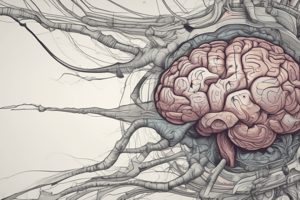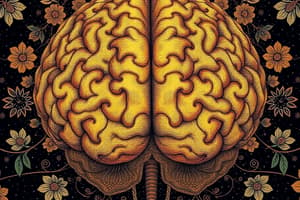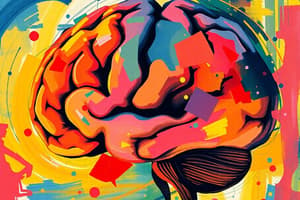Podcast
Questions and Answers
A patient exhibits difficulty initiating voluntary movements. Assuming the cerebral cortex is involved, which specific area is MOST likely affected?
A patient exhibits difficulty initiating voluntary movements. Assuming the cerebral cortex is involved, which specific area is MOST likely affected?
- Temporal lobe, specifically regions related to auditory processing.
- Parietal lobe, focusing on somatosensory processing.
- Occipital lobe, impacting visual-motor coordination.
- Frontal lobe, particularly the motor function area. (correct)
A patient struggles to understand the emotional context of a conversation, even though they comprehend the words being spoken. Which brain structure is MOST likely implicated in this deficit?
A patient struggles to understand the emotional context of a conversation, even though they comprehend the words being spoken. Which brain structure is MOST likely implicated in this deficit?
- The cerebellum, which coordinates physical responses to emotions.
- The frontal lobes, impacting emotional processing and expressive language. (correct)
- The brain stem, affecting basic sensory relay.
- The occipital lobe, disrupting visual interpretation of emotional cues.
A person demonstrates an inability to perform previously learned motor tasks when asked, despite understanding the instructions. Which condition aligns with this presentation?
A person demonstrates an inability to perform previously learned motor tasks when asked, despite understanding the instructions. Which condition aligns with this presentation?
- Alexia, which is a form of acquired reading impairment.
- Anomia, characterized by the inability to name objects.
- Apraxia, representing a motor disorder affecting learned movements. (correct)
- Agraphia, which involves the loss of the ability to write.
A patient presents with visual field cuts and difficulty perceiving the movement of objects. Which area of the cerebral cortex is MOST likely affected?
A patient presents with visual field cuts and difficulty perceiving the movement of objects. Which area of the cerebral cortex is MOST likely affected?
A patient exhibits Wernicke's aphasia. What specific deficit MOST likely results from damage to the associated brain area?
A patient exhibits Wernicke's aphasia. What specific deficit MOST likely results from damage to the associated brain area?
A neurologist is assessing a patient who cannot maintain balance and has difficulty coordinating voluntary movements. Which area of the brain is MOST likely compromised?
A neurologist is assessing a patient who cannot maintain balance and has difficulty coordinating voluntary movements. Which area of the brain is MOST likely compromised?
A patient has suffered damage to their brainstem. Which of the following functions would MOST likely be affected?
A patient has suffered damage to their brainstem. Which of the following functions would MOST likely be affected?
A patient exhibits difficulty with emotional expression and has changes in their motivation levels. Which component of the limbic system is MOST likely implicated?
A patient exhibits difficulty with emotional expression and has changes in their motivation levels. Which component of the limbic system is MOST likely implicated?
Deficits in which neurotransmitter system are MOST likely associated with the muscular rigidity and tremors seen in Parkinson's disease?
Deficits in which neurotransmitter system are MOST likely associated with the muscular rigidity and tremors seen in Parkinson's disease?
In a patient experiencing significant anxiety, which neurotransmitter imbalance is MOST likely contributing to their symptoms?
In a patient experiencing significant anxiety, which neurotransmitter imbalance is MOST likely contributing to their symptoms?
A patient presents with difficulty categorizing objects and shows an increased propensity for aggressive behavior. Which lobe is MOST likely affected?
A patient presents with difficulty categorizing objects and shows an increased propensity for aggressive behavior. Which lobe is MOST likely affected?
A patient, following a stroke, exhibits difficulty with calculations and spatial orientation. Which area is MOST likely damaged?
A patient, following a stroke, exhibits difficulty with calculations and spatial orientation. Which area is MOST likely damaged?
Which of the following is the MOST likely outcome of damage to the olfactory area of the brain?
Which of the following is the MOST likely outcome of damage to the olfactory area of the brain?
Which area is MOST likely affected in a patient that has difficulty with coordination of movement and maintaining posture?
Which area is MOST likely affected in a patient that has difficulty with coordination of movement and maintaining posture?
Which neurotransmitter is responsible for causing calmness?
Which neurotransmitter is responsible for causing calmness?
Which neurotransmitter is considered the major excitatory neurotransmitter?
Which neurotransmitter is considered the major excitatory neurotransmitter?
Which of the following areas is responsible for relaying incoming sensory information?
Which of the following areas is responsible for relaying incoming sensory information?
A patient is experiencing increased difficulties with their sleep. Which area may be affected?
A patient is experiencing increased difficulties with their sleep. Which area may be affected?
An excess of what neurotransmitter is MOST likely associated with depression?
An excess of what neurotransmitter is MOST likely associated with depression?
A patient presents with impaired judgment, planning and difficulty with emotional expression. Which lobe is MOST likely affected?
A patient presents with impaired judgment, planning and difficulty with emotional expression. Which lobe is MOST likely affected?
Flashcards
Motor Function Area
Motor Function Area
Initiates voluntary movements.
Broca's Area
Broca's Area
Involved with muscles of speech.
Sensory Area
Sensory Area
Processes sensation from muscles and skin.
Somatosensory Association Area
Somatosensory Association Area
Signup and view all the flashcards
Wernicke's Area
Wernicke's Area
Signup and view all the flashcards
Frontal Lobe Functions
Frontal Lobe Functions
Signup and view all the flashcards
Frontal Lobe Functions
Frontal Lobe Functions
Signup and view all the flashcards
Frontal Lobe Functions
Frontal Lobe Functions
Signup and view all the flashcards
Frontal Lobe Deficit
Frontal Lobe Deficit
Signup and view all the flashcards
Frontal Lobe Deficit
Frontal Lobe Deficit
Signup and view all the flashcards
Frontal Lobe Deficit
Frontal Lobe Deficit
Signup and view all the flashcards
Frontal Lobe Deficit
Frontal Lobe Deficit
Signup and view all the flashcards
Parietal Lobes
Parietal Lobes
Signup and view all the flashcards
Parietal Lobes
Parietal Lobes
Signup and view all the flashcards
Parietal Lobes
Parietal Lobes
Signup and view all the flashcards
Occipital Lobes
Occipital Lobes
Signup and view all the flashcards
Temporal Lobes Functions
Temporal Lobes Functions
Signup and view all the flashcards
Temporal Lobes Functions
Temporal Lobes Functions
Signup and view all the flashcards
Brain Stem Functions
Brain Stem Functions
Signup and view all the flashcards
Cerebellum Functions
Cerebellum Functions
Signup and view all the flashcards
Study Notes
Frontal Lobes: Functions
- Consciousness, awareness of self and environment, are functions of the frontal lobes.
- Frontal lobes enable the initiation of activity in response to the environment.
- The frontal lobes play a crucial role in making judgments about daily activities.
- Emotional response control, expressive language, meaning to words, and word associations are all functions of the frontal lobes.
- Memory for habits and motor activities resides in the frontal lobes.
Frontal Lobes: Observed Problems
- Damage to the frontal lobes can result in loss of simple movement (paralysis).
- Sequencing, the inability to plan multi-step tasks (making coffee), is an observed problem.
- Loss of spontaneity and flexibility in thinking may occur.
- Persistence of a single thought (perseveration) can manifest.
- Inability to focus (attending), mood changes (emotional lability), and changes in personality and social behavior are observed.
- Difficulty with problem-solving and inability to express language (Broca's aphasia) can arise.
Parietal Lobes: Functions
- Location for visual attention and touch perception are functions of the parietal lobes.
- Goal-directed voluntary movements and manipulation of objects rely on the parietal lobes.
- Integration of senses for understanding concepts takes place.
Parietal Lobes: Observed Problems
- Inability to attend to multiple objects, inability to name objects (anomia), and difficulty with writing (agraphia) are observed problems.
- Difficulties with reading (alexia) and drawing can arise.
- Challenges in distinguishing left from right, doing mathematics (dyscalculia) may occur.
- Lack of body/space awareness (apraxia), impaired visual attention, and poor eye-hand coordination are observed.
Occipital Lobes: Functions
- Vision depends on the occipital lobes.
Occipital Lobes: Observed Problems
- Visual field cuts, difficulty locating objects, and difficulty identifying colors (color agnosia) are observed.
- Hallucinations, word blindness an inability to regonize words, and difficulty recognizing drawn objects are problems.
- The inability to recognize movement (movement agnosia) and challenges in reading and writing arise following damage.
Temporal Lobes: Functions
- Hearing ability, memory acquisition, some visual perceptions and categorization of objects depends on temporal lobes function
Temporal Lobes: Observed Problems
- Difficulty recognizing faces (prosopagnosia) and understanding speech (Wernicke's aphasia) can be problems.
- Disturbance with selective attention is observed.
- Difficulty identifying and verbalizing objects, short-term memory loss, and altered sexual behavior occur with temporal lobe dysfunction.
- Inability to categorize objects, persistant talking due to right lobe damage, and increased aggression can be problems.
Brain Stem: Functions
- Breathing, heart rate, swallowing, reflexes to seeing and hearing (startle response) and digestion are the function of the brainstem.
- Controls sweating, blood pressure, and temperature (Autonomic Nervous System.
- Affects alertness, sleep, and balance (Vestibular Function).
Brain Stem: Observed Problems
- Decreased breathing capacity for speech, swallowing problems (dysphagia), and difficulty with environment perception can manifest.
- Problems with balance/movement, dizziness/nausea (vertigo), and sleeping difficulties (insomnia, sleep apnea) can be observed.
Cerebellum: Functions
- Coordination of voluntary movement, balance, and equilibrium.
- Some memory for reflex motor acts.
Cerebellum: Observed Problems
- Loss of coordination, inability to walk or grab objects, tremors, dizziness (vertigo), and slurred speech can be observed.
- Inability to make rapid movements arises due to cerebellum dysfunction.
Additional Info on Brain Function
- Thalamus functions as a "central switching station" for sensory information (except olfactory).
- Hypothalamus controls the autonomic nervous system and maintains homeostasis.
- Limbic System is related to emotional expression, memory, and motivation.
- Amygdala attaches emotional significance to information and mediates defensive and aggressive behavior.
- Hippocampus: Involved in memory and the transfer of information from short-term to long-term.
Neurotransmitters: The Basics
- There are well over 100 different neurotransmitters
- Psychopharmacology focuses on six key neurotransmitter systems.
Key Neurotransmitter Systems
- Serotonin
- Norepinephrine
- Dopamine
- Acetylcholine
- Glutamate
- GABA (γ-aminobutyric acid)
Acetylcholine
- It is involved in voluntary movement, learning, memory, and sleep.
- Too much it is associated with depression.
- Too little in the hippocampus is associated with dementia.
Dopamine
- It is correlated with movement, attention, learning, and reward.
- Too much in one area of the brain while too little in another has been associated with schizophrenia.
- Too little is associated with some forms of depression and muscular rigidity/tremors in Parkinson's disease.
Norepinephrine
- It mediates fight-or-flight response.
- Too much can lead to anxiety and hyperactivity without actual danger.
- Too little is associated with depression.
Serotonin
- It plays a role in mood, anxiety, emotions, appetite, sleep, and impulsive/aggressive behavior.
- Too little is associated with depression.
GABA (Gamma-Amino Butyric Acid)
- It is a major inhibitory neurotransmitter system in the CNS.
- Causes calmness, sleepiness, reduced inhibition and decreased pain sensation.
- Too little is associated with anxiety disorders.
Glutamate
- Major excitatory neurotransmitter in the brain.
- Required for learning and memory.
- Low levels can lead to fatigue and poor brain activity.
- Increased levels can cause death to neurons and contribute to neurodegenerative diseases, depression, OCD, and autism.
Studying That Suits You
Use AI to generate personalized quizzes and flashcards to suit your learning preferences.




